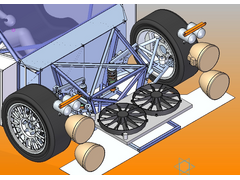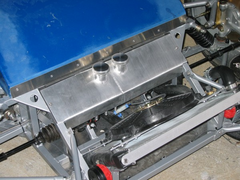
Radiatior sizing.
Doug68 - 20/11/06 at 01:01 AM
Has anyone come across any sort math based method for working out the area required for radiators?
Normally yes you jam in the biggest that will fit, but in my case the the radiators coming first and the hole it fits in will be designed around
that.
Doug
kb58 - 20/11/06 at 04:02 AM
This won't answer your question, but having a good pressure drop across the radiator core is far more important than the size of it. With proper
ducting, an amazingly small radiator works great.
The secret's in proper exit duct design.
Doug68 - 20/11/06 at 04:27 AM
The picture shows the current plan where the air goes in under the radiator and exits through the hood ala Ferrari.
The current radiator size shown is 19" x 30"
What I want to is vertically mount the radiator in front of the forward bulkhead which will mean it'll get a size of ~12" x ~34" and
vent through the wheel arches.
The engine being cooled is a V8 Toyota which in my dreams will one day make ~400hp
Obviously from the nose to the rad will be a sealed duct.
Doug.


Rescued attachment Front.jpg
nitram38 - 20/11/06 at 05:55 AM
It is not a good idea to have a radiator at anything greater than a 30 degree angle to the airflow. Yours will be 90 degrees?
Doug68 - 20/11/06 at 06:11 AM
I lifted the idea straight from Pininfarina.
http://www.seriouswheels.com/2006/2006-Ferrari-P45-Pininfarina-Construction-1024x768.htm
From my point of view the main thing would be to slow the air down to build pressure on the inlet side of the rad. Notice the difference in area
between the radiator and inlet in the picture.
In my case now want to stand the rad upright but thats going to mean a smaller radiator and I don't want to fry the motor. Hence my question on
how to work out radiator sizes.
RazMan - 20/11/06 at 08:11 AM
I may have misunderstood your drawing / description but if the rad is placed flat & horizontal you will have to fabricate some efficient ducting
to change the airflow direction for maximum efficiency, therefore the rad size will have to increase to compensate. If you have the rad at about 30-45
degrees the airlow will be changed BY the rad and you just need to look at the exit ducting.
I am running a Duratec 2.5 V6 with a Polo rad and it does the job suprisingly well.


Rescued attachment Combo Tank 2.jpg
Doug68 - 20/11/06 at 09:12 AM
Yes obviously it'll need to be fully ducted in on the inlet side, I didn't get that into the model yet as I'm still toying with the
placement.
bimbleuk - 20/11/06 at 09:37 AM
Have a look at the Elise layout. The radiator is basically horizontal. They were allegedley sized to cool up to 200BHP. The VHPD engines are 197BHP
(when properly tuned)
There are quite a few Audi/Honda engined Elises' out there with 300BHP and even more and they seem to be working fine. I believe they do have up
rated rads though.
The cooling issues on the Elise are related to the thermo stat position, liner movement and head gasket design.
nitram38 - 20/11/06 at 11:18 AM
You will need to install curved baffles to re-direct the airflow and from the pictures, the pinafarina car has the rad a lot higher up than your
design. I suspect the egg crate grill is part of the ducting.
I have had cooling issues with my car until I re adjusted my rad from 45 degrees to 30 degrees.
I can't remember where I read this, but it is one of those things that you will find out when you drive at speed.
My car was fine in traffic, but on motorways the temperature slowly climbed. This is because the airflow took the path of least resistance. Changing
the angle meant no more cooling issues.
The rad was even located in a enclosed duct.




